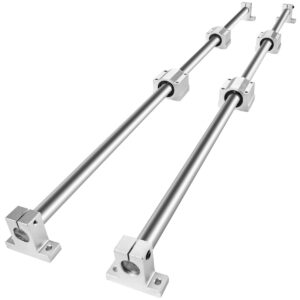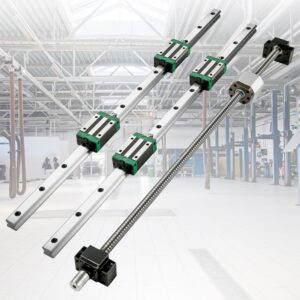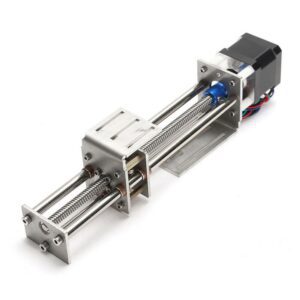Outline for “Linear Rail System”
| Section | Subtopics |
|---|---|
| Introduction | Importance of linear motion systems in modern industries |
| What Is a Linear Rail System? | Definition, components, and working principle |
| History and Evolution of Linear Rail Systems | How technology has evolved for precision applications |
| Core Components of a Linear Rail System | Rails, carriages, rolling elements, seals, and end caps |
| How a Linear Rail System Works | Motion mechanism and friction reduction |
| Types of Linear Rail Systems | Ball-type, roller-type, and cross-roller guides |
| Linear Rail System vs. Linear Bearing | Key differences and applications |
| Material Selection in Linear Rail Systems | Stainless steel, alloy steel, and coatings |
| Precision Grades and Tolerance Levels | Accuracy classifications (C, H, P, SP) |
| Advantages of a Linear Rail System | Rigidity, accuracy, efficiency, longevity |
| Applications of Linear Rail Systems | CNC, robotics, automation, packaging, and 3D printing |
| Installation and Alignment | Step-by-step guide for perfect setup |
| Lubrication and Maintenance | Extending lifespan through proper care |
| Common Problems and Troubleshooting | Misalignment, vibration, wear, and lubrication issues |
| Design Considerations for Engineers | Load, stroke, speed, and mounting factors |
| YH Linear’s Linear Rail System Solutions | Brand overview and product lineup |
| Why YH Linear Outperforms Competitors | Precision, innovation, and customer support |
| Case Studies: Linear Rail Systems in Action | Industrial and robotic applications |
| Future of Linear Rail Technology | Smart sensors, self-lubrication, and automation trends |
| FAQs | Six practical questions with detailed answers |
| Conclusion | Summary and brand call-to-action |
| Suggested Inbound and Outbound Links | SEO recommendations for internal and external links |
Linear Rail System
A linear rail system lies at the heart of modern precision motion equipment. Whether in CNC machining, industrial automation, semiconductor assembly, or robotic systems, these rails ensure smooth, accurate, and repeatable motion.
At YH Linear Motion Systems (https://yhlinear.com/), we specialize in designing and manufacturing linear rail systems that combine precision engineering with reliability, meeting the most demanding performance standards in the industry.
What Is a Linear Rail System?
A linear rail system is a mechanical assembly designed to guide motion in a straight line with minimal friction. It typically consists of:
Guide rails, which provide the linear path.
Carriage blocks (also known as sliders or runners) that move along the rails.
Rolling elements, such as balls or rollers, that minimize friction between the rail and carriage.
These systems enable precise positioning and smooth motion under heavy loads. They are the backbone of automation equipment, CNC machines, 3D printers, inspection systems, and medical devices.
History and Evolution of Linear Rail Systems
Linear motion technology dates back over a century, initially relying on simple plain slide bearings lubricated with oil. Over time, engineers replaced sliding friction with rolling contact designs, creating the first linear ball bearing systems.
Today, companies like YH Linear lead in developing hardened steel rails, micro-finished raceways, and low-noise ball recirculation systems. This evolution enables applications that demand sub-micron accuracy and repeatability in high-speed environments.
Core Components of a Linear Rail System
A linear rail system is made up of several precision-engineered parts:
| Component | Function |
|---|---|
| Guide Rail | Provides the linear path for motion |
| Carriage (Slider Block) | Moves along the rail and carries the load |
| Rolling Elements | Balls or rollers that reduce friction |
| End Caps & Return Systems | Ensure smooth recirculation of rolling elements |
| Seals & Wipers | Keep out dust and contaminants |
| Lubrication Ports | Allow consistent lubrication for long-term performance |
At YH Linear, each component is manufactured using CNC-controlled grinding and polishing to ensure consistent accuracy and surface quality.
How a Linear Rail System Works
Linear rail systems operate on the rolling contact principle. Tiny steel balls or rollers circulate within the carriage block as it moves along the rail. This rolling motion eliminates sliding friction, allowing the system to handle heavy loads with minimal wear.
The result? Low resistance, high stiffness, and extreme accuracy, making them ideal for robotics, CNC, and semiconductor positioning systems.
Types of Linear Rail Systems
Ball-Type Linear Rails:
Most common design; features circulating ball bearings for smooth, low-friction motion.Roller-Type Linear Rails:
Use cylindrical rollers instead of balls for higher rigidity and load capacity.Cross-Roller Guides:
Offer ultra-high precision and stiffness for optical or measurement instruments.Miniature Linear Rails:
Designed for compact applications like 3D printers, small robots, and lab automation.
Linear Rail System vs. Linear Bearing
| Feature | Linear Rail System | Linear Bearing |
|---|---|---|
| Motion Path | Fixed linear path on rails | Shaft-based linear motion |
| Load Capacity | High | Moderate |
| Rigidity | Superior due to double rail contact | Lower |
| Precision | Micron-level | Millimeter-level |
| Applications | CNC, robotics, automation | Light-duty motion systems |
In short, linear rail systems are the high-performance alternative when precision and load capacity are paramount.
Material Selection in Linear Rail Systems
YH Linear’s rails are crafted using premium-grade materials to ensure durability:
Stainless Steel (SUS440C) — Corrosion-resistant and ideal for clean environments.
Alloy Steel (SCM415) — Offers strength and hardness for heavy-duty use.
Hard Chrome or Nickel Coating — Enhances wear resistance and reduces friction.
Surface finishing and precision grinding ensure long-term stability even under dynamic loads.
Precision Grades and Tolerance Levels
Linear rail systems are classified by precision grades, such as:
| Grade | Description | Accuracy (μm) |
|---|---|---|
| C (Normal) | Standard industrial use | ±20 |
| H (High) | Automation-grade | ±15 |
| P (Precision) | CNC-grade | ±10 |
| SP (Super Precision) | Semiconductor-grade | ±5 |
YH Linear offers all precision levels, ensuring the perfect match for your application’s performance and budget.
Advantages of a Linear Rail System
High Accuracy: Micron-level precision for exact motion control.
Low Friction: Rolling contact ensures smooth motion.
High Rigidity: Dual-contact design resists deflection.
Long Service Life: Hardened raceways and superior lubrication.
Quiet Operation: Optimized ball circuits reduce vibration.
Compact and Efficient: Reduces machine footprint and energy consumption.
These features make linear rail systems indispensable in advanced manufacturing.
Applications of Linear Rail Systems
Linear rail systems are widely used in:
CNC Machines (milling, engraving, routing)
Robotics and Automation
Semiconductor and Electronics Assembly
3D Printers and Laser Equipment
Medical and Laboratory Instruments
Packaging and Inspection Systems
YH Linear’s rails are engineered to deliver reliable performance across all these sectors.

Installation and Alignment
For optimal performance:
Clean and deburr the mounting surface.
Align the first rail using precision tools.
Mount with even torque across bolts.
Align the second rail parallel within tolerance.
Check for smooth, consistent motion.
Lubricate before use.
YH Linear provides installation guides and consultation for OEMs to achieve perfect alignment.
Lubrication and Maintenance
Proper lubrication ensures long-lasting performance. Use high-quality lithium grease or specialized linear guide oils.
Maintenance tips:
Re-lubricate after every 500 km of travel.
Clean contaminants regularly.
Check seals and replace when worn.
Avoid exposure to high moisture or dust.
With proper maintenance, YH Linear’s rails can achieve over 30,000 km of operational life.
Common Problems and Troubleshooting
| Issue | Possible Cause | Solution |
|---|---|---|
| Vibration/Noise | Poor alignment or contamination | Clean and re-align |
| Uneven Motion | Lack of lubrication | Reapply lubricant |
| High Friction | Rail damage or preload too tight | Inspect and adjust |
| Wear Marks | Dust ingress | Replace seals and clean environment |
YH Linear’s customer support team provides real-time assistance for technical issues.
Design Considerations for Engineers
When designing systems using linear rails:
Calculate load (N) and moment forces (Mx, My, Mz).
Define required travel stroke and accuracy.
Select appropriate rail size and precision grade.
Ensure parallelism and rigidity in mounting structure.
Include lubrication points and protective covers.
Proper design ensures optimal rail lifespan and machine accuracy.
YH Linear’s Linear Rail System Solutions
YH Linear offers a comprehensive product portfolio, including:
H-Series: High load, industrial-grade linear rails.
M-Series: Miniature rails for compact automation.
S-Series: Stainless steel for clean environments.
C-Series: Customizable rails for OEM machinery.
Every YH Linear product is manufactured under strict ISO quality systems to ensure global consistency.
Why YH Linear Outperforms Competitors
Advanced CNC production for rail grinding and assembly.
100% dimensional inspection before shipment.
Custom preload options for specific rigidity needs.
Rapid delivery and technical after-sales support.
Proven performance across multiple industries worldwide.
Visit https://yhlinear.com/ to explore our precision motion solutions.
Frequently Asked Questions
What is a linear rail system used for?
It guides motion in a straight line with high precision, often in automation and CNC machinery.
Are linear rails better than shafts?
Yes, they offer higher rigidity, load capacity, and accuracy compared to round shafts.
How long do YH Linear rails last?
With proper lubrication, service life can exceed 30,000 km.
Can linear rail systems be customized?
Yes, YH Linear provides OEM/ODM customization for dimensions, materials, and coatings.
Do they require lubrication?
Absolutely—consistent lubrication is vital for smooth performance and longevity.
Where can I buy YH Linear rails?
Directly from https://yhlinear.com/ or through authorized distributors.
Conclusion
The linear rail system is a cornerstone of precision motion technology, enabling smooth, reliable, and accurate linear movement. With innovations in design, materials, and coatings, YH Linear stands at the forefront of this field.
Whether you’re developing robotic arms, CNC machines, or automated assembly lines, YH Linear delivers the engineering precision you can trust.
👉 Learn more and request a quote today at https://yhlinear.com/.
Suggested Inbound and Outbound Links
Inbound Links (YH Linear site):
Outbound Links:



